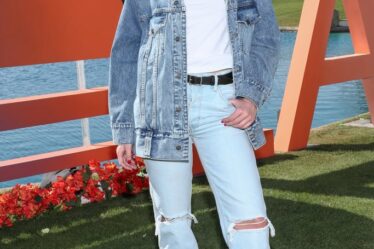
LONDON — Uniqlo’s newest flagship store in Covent Garden doubles as a shrine to its cross-body bag.
A large section of wall space on the ground floor is dedicated to the $20 viral accessory in dozens of colourways. Nearby, there’s a display featuring a screenshot of the TikTok that started it all, in which influencer Caitlin Phillimore demonstrated how many of her belongings, from headphones to snacks, she was able to fit into the bag. There’s also a case containing replicas of all of those items.
Since Phillimore posted her ode to Uniqlo in April 2022, countless others have created “what’s in my bag” TikToks featuring the cross-body bag, and #uniqlobag has 70 million views on the platform.
Uniqlo doesn’t usually get this kind of buzz, particularly with Gen-Z consumers in North America and Europe. In those regions, the brand has struggled to meet parent Fast Retailing’s ambitious sales goals, and is often lumped in shoppers’ minds with Gap or J.Crew as a source of affordable basics. But the recent run of hit products on TikTok has provided a jolt to the brand’s image. So has the ongoing trend of understated dressing, as well as the persistent inflation that has made its $15 T-shirts and $50 parachute pants much more attractive to cash-strapped consumers.
The brand’s newfound status with Gen-Z has been a major driver of sales and profit growth in the past year, according to Taku Morikawa, Uniqlo’s chief executive for Europe. Revenue for Uniqlo International — the brand’s non-Japanese markets — was ¥755.2 billion ($5.5 billion) in the six-month period ending February 2023, up 27.3 percent from the same period the year before, according to parent company Fast Retailing, which also owns Theory and Helmut Lang. Profit across the group increased by ¥30.9 billion ($226 million), with North America and Europe accounting for 80 percent of this gain, according to the February earnings report.
Now, Uniqlo has to make the right moves to ensure it’s not just another fleeting TikTok trend.
“It wasn’t clear to me exactly what Uniqlo was about,” said retail analyst Doug Stephens. “And in such a crowded market, consumers don’t have the time to wait around to find out.”
Retail Strategy
The 1,450-square-metre Covent Garden store is a part of the company’s strategy to solidify its newfound status with Gen Z. It has dedicated space for bra tops offered in a range of bright colours, a departure from Uniqlo’s typically muted colour palette, and loose-fitting parachute pants — another TikTok hit that frequently sells out.
Uniqlo is on track to open 20 to 30 new stores in Europe and North America every year, Fast Retailing chief financial officer Takeshi Okazaki said in a recent earnings call. The company plans to increase its North America store count to 200 by 2027, up from its current total of 63.
Inside these stores, there will be a more localised approach to merchandising and messaging to customers, a shift away from Uniqlo’s prior practice of treating stores in the same continent as one block. At Covent Garden, there are London-specific products, such as an apparel collaboration with Transport for London.
Uniqlo appears to have learned from its previous expansion attempt in North America, when failing to understand localised consumer needs saw the brand fail to convert shoppers and forced it to put the brakes on an aggressive physical retail expansion plan in 2015.
“Previously, we treated Europe as one business, with the same merchandising mix and marketing strategy for each country in the region,” Morikawa said. “Now we understand that customer needs in each country are different, and we use our flagship stores in each market to showcase products and collaborations for that specific customer.”
Meanwhile in Europe, the Tokyo-based retailer is also planning a revamp of its Paris flagship store and will open a three-story flagship in Luxembourg — its first in the country — in autumn this year.
“Our share [Europe and the US] is still extremely small, so we feel that there is great potential for us to grow,” Okazaki said.
Favourable Trends
Fashion’s current obsession with “quiet luxury” may have also played a critical role in driving growth for Uniqlo in recent months.
Its minimal, logoless clothing and emphasis on well-tailored basics, such as its best-selling boxy linen shirts and stretchy chinos, resonates with the understated way of dressing that’s dominating the fashion cycle, and the affordable prices certainly don’t hurt.
Uniqlo’s Lifewear collection, which includes functional pieces such as its Heattech thermal tops and down jackets, has been particularly successful in driving young first-time customers. The popularity of collaborations with the likes of Jonathan Anderson and Christophe Lemaire — now the brand’s full-time artistic director — has also helped the brand boost interest in its main line clothing, according to Morikawa.
Meanwhile, the retailer recently tapped Japanese streetwear designer and artist Kosuke Kawamura to be the creative director of UT, Uniqlo’s T-shirt line known for licensed collaborations with Disney, American artist Kaws and the popular anime series Attack on Titan.
Kawamura’s appointment is designed to boost the fashion credentials of the line that has proved popular among Gen Z consumers, allowing Uniqlo to tap into multiple niche interest groups through limited collaborations.
These efforts have not gone unnoticed.
“In terms of the repositioning of the Uniqlo brand, I see them ticking a lot of boxes, whether that’s livestream shopping, in-store marketing events, celebrity partnerships, or designer collaborations,” said Stephens.



